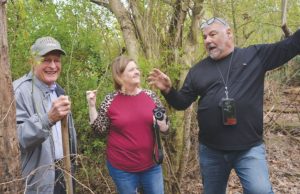
A patch of trees and overgrown brush sat undisturbed in an open field off N.C. Highway 55 for decades. To most people driving by, nothing about it seemed out of place or part of something even bigger.
For Cindy Atkins and Wesley Johnson, who both spent much of the past year looking for such sites, the small island of weeds, thickets and thorns signaled a possible piece of a much larger jigsaw puzzle. Upon closer inspection, Atkins and Johnson found a part of Dunn’s history forgotten by time and lost to Mother Nature.
This particular cluster of growth camouflaged yet another local cemetery left behind over the years, recognized only by toppled headstones from a time long ago.
“This is family history, the history of Dunn,” said Atkins, a member of the Dunn Area Cemetery Preservation & Genealogy Group. “This is where our roots are from.”
Atkins initially embarked on her preservation efforts last year when the Interstate 95 expansion project forced the relocation of her family cemetery. Once Atkins started pulling historical strings connected with her own kin, she found Dunn had several such cemeteries literally hidden amongst the weeds. The Dunn Area Cemetery Preservation & Genealogy Group, which is under the Dunn Area History Museum, went on to identify a dozen lost cemeteries, using state archives, newspaper articles, death certificates and even a 40-year-old social studies project to aid in the endeavor.
“It started when they moved Taylor Cemetery,” Atkins said. “We just went from there. I received a project from a social studies class in 1976 where they assigned students to go out to different cemeteries and draw a map. I took pictures of every bit of it. We’ve been walking through woods trying to find cemeteries ever since.”

Of the estimated 20 newly found graves, most of which are unmarked, Atkins discovered a link to someone who made a name for himself in NASCAR as a crew member for the late Dale Earnhardt. Danny “Chocolate” Myers recalled coming to Dunn as a child with his grandmother, Flonnie Wade. When Myers heard about Atkins’ find, he and wife, Caron, made the trip from Davidson County for a peak into his own family tree.
“My grandmother’s side [of the family] are all from here,” said Myers. “She was from Dunn and talked about it a lot. She had sisters here, her family was here. I remember growing up with cousins, the Wades, Jernigans, Godwins, which all were out of this area. Every once in awhile we would load up and come to Dunn. It seemed like a big trip back then. We all have those childhood memories and you remember things the way they were.”
Myers said he never really thought about his family’s history until retirement provided him the time to explore other interests. One of the toppled headstones Myers looked at on Friday morning belonged to G.W. Wade, his great, great grandmother’s brother, who also happened to share a family tree with Atkins. Myers also went deep into the brush to see the headstone of Private Radford Smith, a medic who died in France during World War I.
“You don’t want to see people forget them,” Myers said. “They don’t deserve that. We just want to make sure, whether it’s here or where we live now, that we know where we came from. It’s important because it’s family.”
Modern scanners and old school techniques like divining rods helped Atkins’ group locate dozens of unmarked graves over the past year. Finding the plots only starts the detective work. Information on parceled land often resides in multiple counties, Caron Myers said, making it harder to track down who owned what and when. With records scattered all over the state, archives proved to be one of the most efficient ways to unlock the past.

“It’s a jigsaw puzzle,” said Caron Myers, a former news anchor with Fox 8 in High Point. “It’s like a mystery and you do the investigative work.”
Once graves are located and identified, one idea involved putting up a fence around the site and adding a marker with the names of all who are buried there. Johnson said cemetery projects not only provide families with information about loved ones, but open an avenue to promote history and encourage people to take a vested interest in Dunn’s past.
“It’s important to us individually because this particular cemetery has family links to Cindy and others, so there is personal motivation,” Johnson said. “From the history museum perspective, we see it as an opportunity to inspire people to take an interest in their local history. That’s why we set up the genealogy group is to give them a mechanism. The grandchildren or great grandchildren of these families don’t know the history around some of these cemeteries or that they even exist. Whenever we identify the cemetery, we start doing research and we try to find family members and encourage them to be involved with the museum.”
Atkins and Johnson this week helped complete another part of a larger, complex puzzle. The next piece of history could very well be hidden in another patch of trees and overgrown brush somewhere off the beaten path.
-Dunn Daily Record














